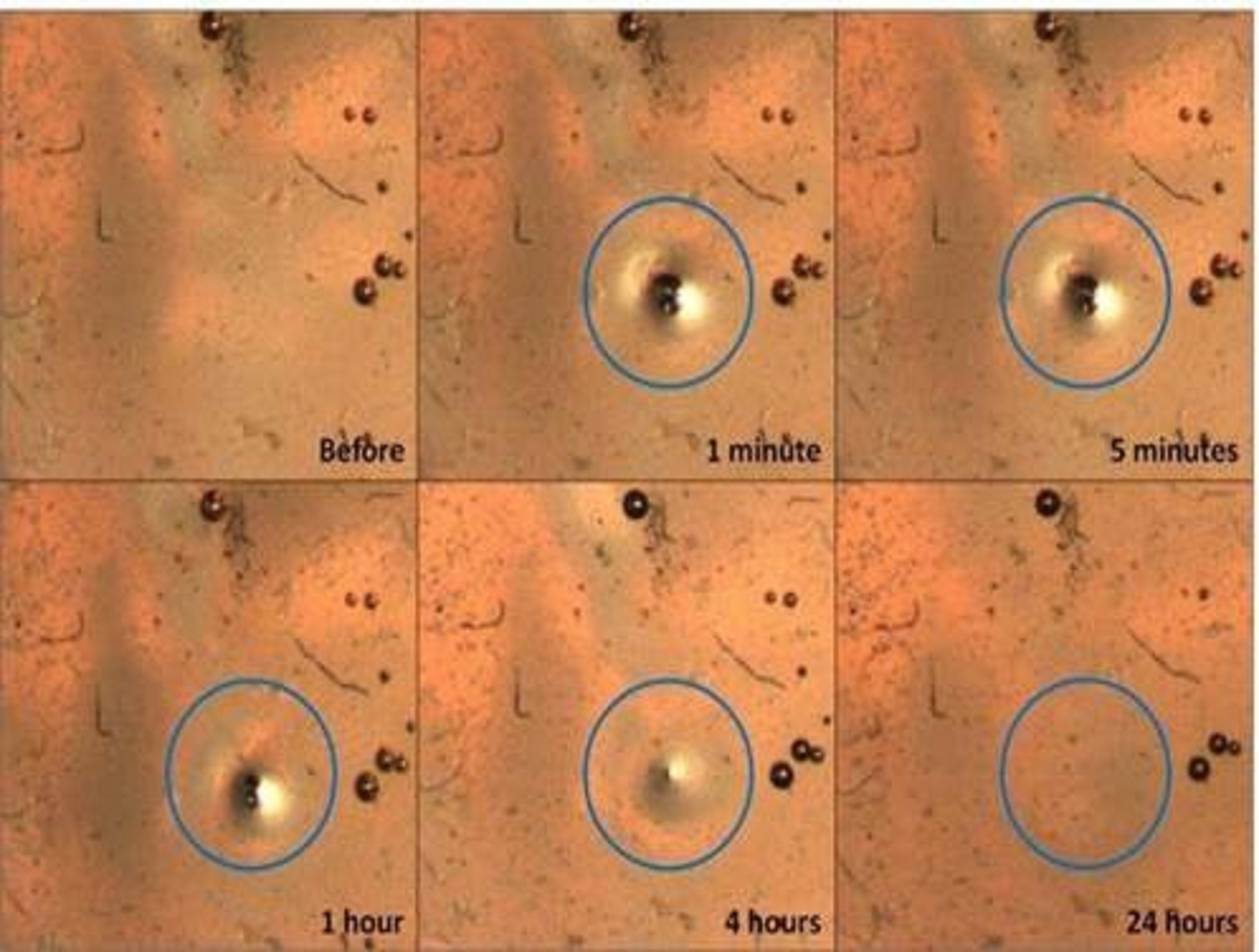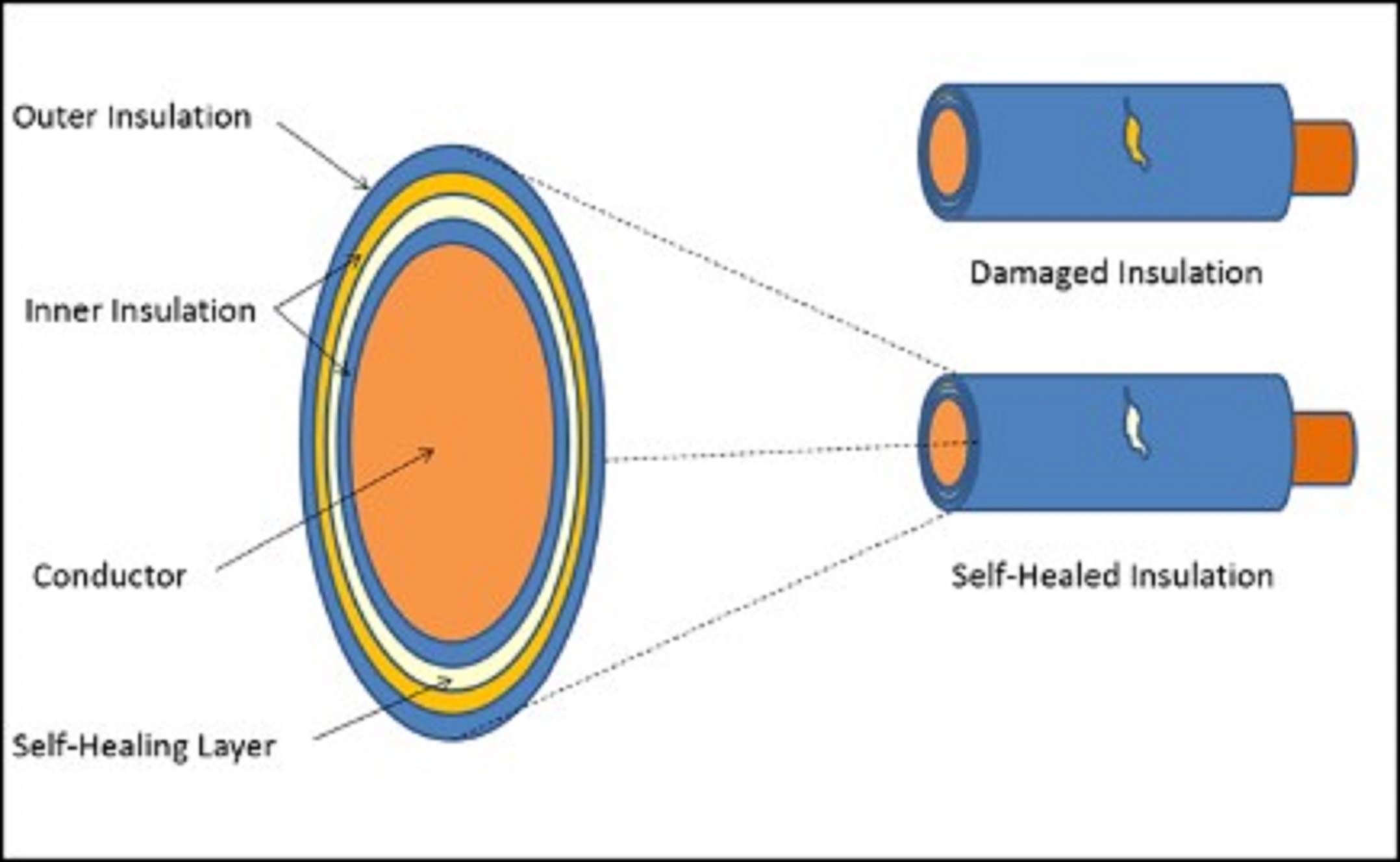Self-Healing Low-Melt Polyimides
Materials and Coatings
Self-Healing Low-Melt Polyimides (KSC-TOPS-46)
Flexible thin-film polyimides can self-repair minor cuts, nicks, and abrasions
Overview
NASA Kennedy Space Center seeks partners interested in the commercial application of a thin-film, high performance, polyimide and self-healing/sealing systems for nearly a decade. (KSC) is now seeking commercial partners for licensing or further development of these novel high performance, flexible, low-melt polyimide film with self-healing properties. The self-healing/sealing properties of the materials are provided as a self-sealing polyimide film, a layered composite, as a healant in embedded microcapsules, or combination thereof. When cut or otherwise damaged, the self-sealing film and/or microcapsule healant will result in a repair of the damaged area. The capability to heal or self-repair in such applications as wire insulation, inflatable structure inner linings, spacesuits, and solar panels is a key technology area for NASA, and developmental testing of these novel materials has shown great promise.
The Technology
There are multiple space-related systems that can benefit from high performance, thin film, self-healing/sealing systems. Space vehicles and related ground support equipment can contain miles of wire, much of which is buried inside structures making it very difficult to access for inspection and repair. Space-based inflatable structures, solar panels, and astronauts performing extra-vehicular activities are subject to being struck by micrometeoroids and orbital debris. Self-healing or sealing layers on inflatables, solar panels and spacesuits would increase the safety and survivability of astronauts as well as the survivability and functionality of inflatables and solar panels. Self-healing insulation on wiring would greatly improve the reliability and safety of systems containing such wiring and reduce inspection and repair time over the lifetime of those systems. This technology combines the use of a self-sealing low melt, high performance polyimide film that exhibits the ability, when cut, for separated edges to slowly flow back together and seal itself, with the options of a laminate system and the inclusion of healant microcapsules that, when broken, release healant which can then additionally assist in the healing process. Combinations of the healing approaches can be enabling to the healing process proceeding at a much greater rate and dual mode healing approach can also allow for healing of a larger area.


Benefits
- Reduced Maintenance - Self-healing of minor cuts, nicks, and abrasions on wire insulation, solar panels, and inflatable structures can substantially reduce the need to perform inspection, troubleshooting, repair, and/or replacement of damaged parts.
- Reduced Cost - Wiring and sub-assemblies incorporating self-healing surfaces can self-repair minor damage, thus greatly reducing the cost of materials and labor required for the repair or replacement of damaged wiring and parts.
- Improved Reliability - Self-healing of minor damage can help improve system mean-time-between-failure. Damage (e.g., shorting, sparking, crack propagation, degradation of barrier integrity) that would otherwise continue worsening and lead to failure is repaired without maintainer intervention or further system degradation.
- Improved Safety - Self-healing capability in wire insulation helps prevent shorts which can lead to sparking and conditions conducive to fires. Self-healing of minor damage to spacesuits or inner liners of inflatables helps prevent loss of pressurization and loss of life.
Applications
- Aerospace (Aircraft, Helicopters, Rockets, Expandable or Inflatable structures/architectures)
- Defense (Missiles, Ground Vehicles, Habitation Tents
- Ships, Submarines, Unmanned Aerial Vehicles)
- Automotive
- Power Production (Wiring, Solar Panels)
- Textiles
- Protective Coatings
|
Tags:
|
|
|
Related Links:
|
Similar Results

Self-Healing Wire Insulation
Insulation is necessary on electrical wires in order to protect electrical systems from shorting. In high voltage systems such shorting can lead to sparking and fires. Many lives have been lost due to electrical wire insulation failure. Many man hours are also expended in the repair and inspection of electrical wiring in order to attempt to prevent wire failure. Wire insulation with a built in "self-healing" capability would greatly improve the safety of systems containing electrical wiring. Such insulation would require far less inspection and repair time over the lifetime of the system.
Polyimides such as Kapton are an integral part of high performance electrical wire insulation. Traditional polyimides are very inert to solvents and do not melt. A new set of polyimides, developed for use as films for the manual repair of high performance electrical wire insulation, have a low melting point and can be dissolved in special solvents. These properties can be taken advantage of in self-healing polyimide films. Microcapsules containing a solvent soluble polyimide are prepared using industry standard inter-facial or in situ polymerization techniques. These capsules are then incorporated into a low melt polyimide film for use as either a primary electrical wire insulation or as one of several layers of a composite wire insulation. The low melt polyimide film substrate in which the microcapsules are incorporated has good solubility with the solvent used to dissolve the polyimide which makes up the fluid inside the microcapsule. Such a capsule filled insulation, when cut or otherwise damaged, will result in the release of the capsule contents into the cut or damage area. The solvent then dissolves a small amount of the surrounding polyimide insulation but will also begin the process of evaporation. The combination of these two processes allows for excellent intermingling of the healant and the surrounding substrate, resulting in a repair with superior bonding and physical properties.

Puncture-healing Engineered Polymer Blends
Puncture healing melt blends were developed by melt blending self-healing polymers with non self-healing polymeric materials. The self-healing polymeric materials consisted of Surlyn® 8940, Affinity™ EG 8200 G, and poly(butadiene)-graft-poly(methyl acrylate-co-acrylonitrile) or Barex® 210 IN. The non-self-healing polymeric materials consisted of poly(ether ether ketone) (PEEK), LaRC phenyl ethynyl terminated imide 330 (LaRC PETI 330), and Raptor Resins Bismaleimide-1 (BMI-1). Puncture healing blends were also prepared with chopped glass and chopped carbon fibers. The overall goal was to develop a product with superior properties relative to either of the starting materials. The melt blends were prepared in varying compositions to optimize desired properties of the resulting matrix. Ballistic testing was conducted to determine the self-healing characteristics of several developmental polymers subjected to micrometeoroid type damage.

Mechanoresponsive Healing Polymers
The method chemically introduces mechanically sensitive chemical groups into the structure of a resin. By introducing mechanoresponsive functional groups to a polymer, it is possible to induce self-healing through the transformation of such chemical groups to where mechanical properties of a structure are almost completely restored. The forces imparted by a damage event can therefore be used to enable healing or repair of the structure.

Multi-layered Self-healing Material System for Impact Mitigation
This innovation utilizes a tri-layered structure, comprised of solid plastic front and back layers sandwiching a viscous, reactive liquid middle layer. Combined, this system provides rapid self-healing following high velocity ballistic penetrations. Self-healing in the front and back layers occurs when the puncture event creates a melt state in the polymer materials and the materials melt elasticity snaps back and closes the hole. The viscous middle layer augments the self-healing properties of the other layers by flowing into the gap created by a ballistic puncture and concurrently solidifying due to the presence of oxygen. Thus, this innovation has two tiers of self-healing: a puncture-healing mechanism triggered by the projectile and a second mechanism triggered by the presence of oxygen.
RTV Silicone Sealing Method for Component Interfaces
NASA designed an inflatable habitat intended for space whose exterior incorporates an expandable layer known as the bladder – the main pressure shell of a module to which astronauts may reside while off-world. The bladder is made from a polymer material and is surrounded by protective layers to ensure it is not damaged and does not leak. On every module, there are two areas where the bladder and other flexible layers interface with the ends of a cylindrical core, at the bulkheads. Seals between the non-metallic bladder and the metallic bulkhead are critical in maintaining a safe pressurized environment for astronauts to live and work.
With both bulkhead plates assembled, RTV silicone is deposited in specially designed channels which are sandwiched between the plates. After the channels are filled, a cure-in-place seal is formed between the bladder and the bulkhead.
The RTV sealing method worked successfully during prototype testing as confirmed by a helium leak test and post-test visual inspection of the seals. In prototype testing, this method created a consistent and reliable seal between the bladder and bulkhead assembly replicated from the inflatable module design. The RTV sealing method may benefit terrestrial applications that may demand cure-in-place internal seals. The method could also innovate manufacturing processes for components by enhancing the speed of assembly while increasing seal integrity.



